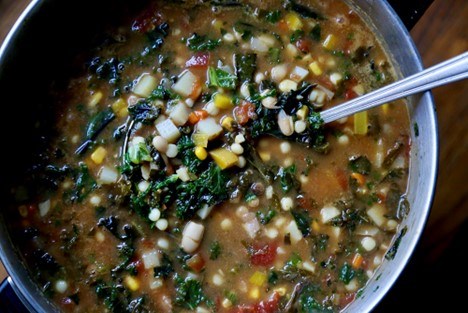Slow soup, it is said, is to the body what peace is to the soul. Healing and nurturing, warm and loving, like a deep and delicious hug at the doorstep of winter.
In and around our home a this time of year, we are preparing winter garden beds, stacking firewood, restocking the pantry, and dreaming of “medicine soup.” Inevitably, we need room in the freezer for winter protein, and so begins the annual ritual of removing surplus spring and summer vegetables, leftover rice, and quarts of veggie scrap stock that accumulated over the seasons.
All of these beautiful ingredients end up in our 24-quart stockpot, where they simmer slowly, concentrating the extraordinary flavour and goodness created by long days rooted in living soil.
To this somewhat arbitrary starter, we add any combination of diced homegrown onion, garlic, potato, beet, squash, rutabaga, and turnip, and some of the tender shoots from fall sprouted broccoli and other brassicas. After one long slow day of tasting, stirring and seasoning, we have our annual store of potage for sharing with family and friends.
Chiffonade of curly, redbor and dinosaur kale — yes, kale — figure prominently in the soup. To be honest, if I never ate raw kale again, it would be too soon, but roast, dry, fry, sauté, braise or stew it, and we are talking big-time love affair.
That kale is one of the most nutrient-dense vegetables on the planet, is well known, but this cook loves it most for its stability of texture, colour and flavour. I can braise kale in advance, then sauté it back to life in full colour without anyone being the wiser. I can freeze, thaw, then cook or juice kale as if it were fresh.
Unlike its popular and impossibly healthy cousin spinach, kale is high in fibre and doesn’t shrink down to nothing when you sauté or braise it. To my way of thinking, kale provides higher veggie garden return on investment than any other green.
Cooked kale, like other so-called winter greens, is admittedly, somewhat bitter with goodness, reminding us always, that food is medicine, and that growing medicine is a conscious pursuit.
Growing kale can be challenging for new gardeners. The beautiful but dreaded white cabbage moth uses multiple senses to find brassica leaves under which to lay microscopic eggs. Those eggs hatch into deadly, felty green caterpillars that can decimate host plants in short order.
The trick, I have learned, is to fool the moths into moving on and away from our property. We do this by planting kale seedlings haphazardly, hither and yon through our gardens — some interplanted in raised beds, some among herbs and perennials, and some in pots and planters.
Scout moths it seems, become confused as they flit about, taking off and landing repeatedly in pattern, throughout the garden, looking for block patches or rows of brassicas suitable for sheltering and feeding their spawn. By diluting and diversifying plantings, we have been successful in reducing pest pressure overall, while improving soil health and biology, and ensuring a seemingly endless supply of kale for family, friends, and the freezer.
One should, I was taught, blanch kale before freezing, though I don’t see the point because I typically cook it straight away. I simply wash kale then chiffonade it; pack it into recycled freezer bags (one quart bag holds 12 large leaves, chopped); then roll the bags tight to remove air and create low-profile stackable bundles of goodness.
I just finished making our annual batch of kale-enriched medicine soup. Adding condensed broths and gravies saved from hot pots and celebration meals enjoyed throughout the year, rendered the soup especially unctuous. After the last-minute addition of buttery homegrown, high-fibre and protein-rich Romano beans, and several cups of chopped mixed herbs, the soup was left to cool and portion for the freezer.
Our ancestors I think, were onto something, honouring as they did, the nutritious and delicious pot au feu that simmered quietly, all night and day, at the back of their wood-burning stoves. Daily additions of organic vegetables, bones or protein kept the pots topped up, and bellies full. Good medicine.
Laura Marie Neubert is a West Vancouver-based urban permaculture designer. Follow her on Instagram @upfrontandbeautiful, learn more about permaculture by visiting her Upfront & Beautiful website or email your questions to her here.
For a taste of permaculture, click on the YouTube link below:
(Video - Courtesy of West Vancouver Memorial Library)



